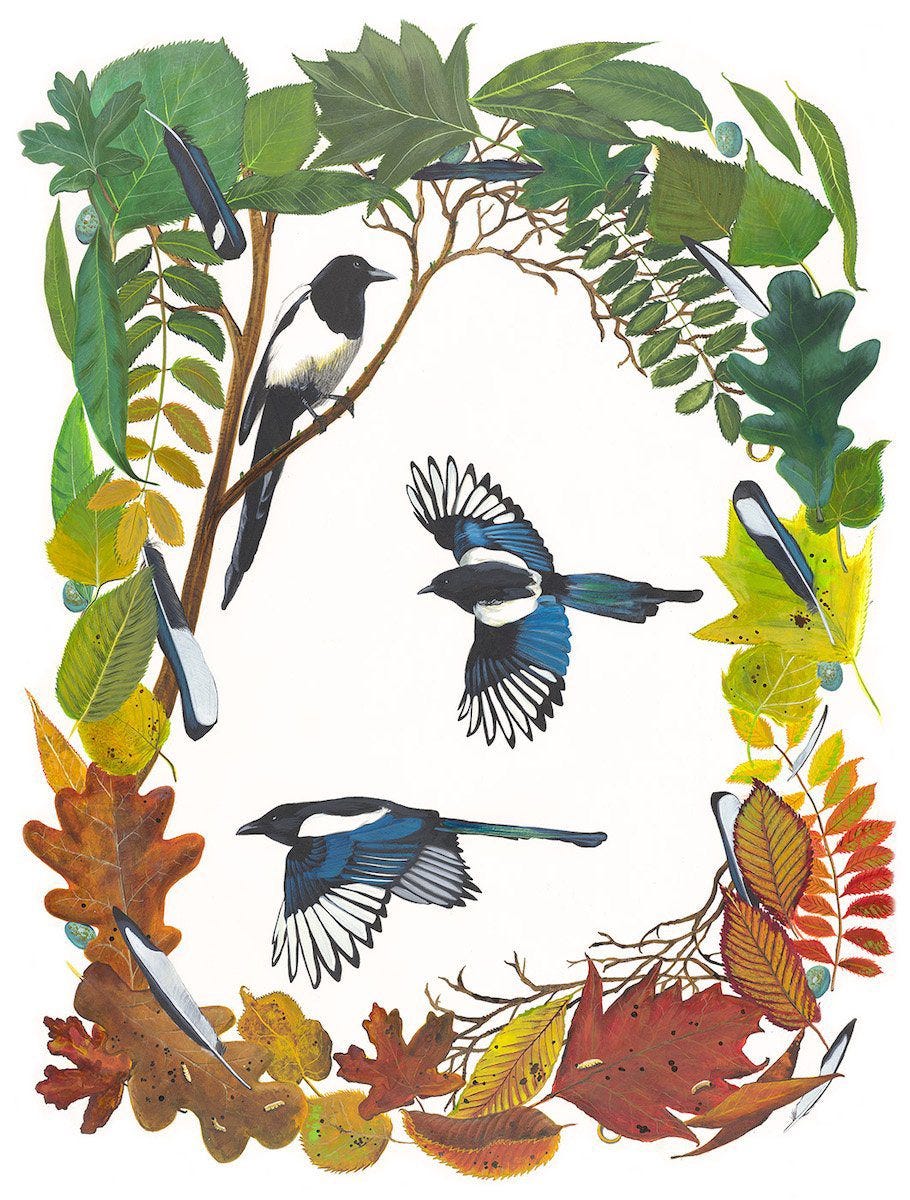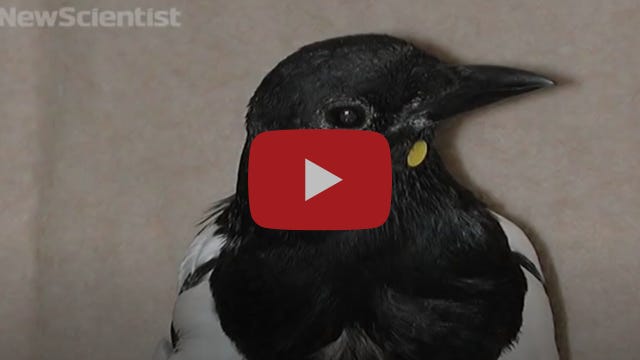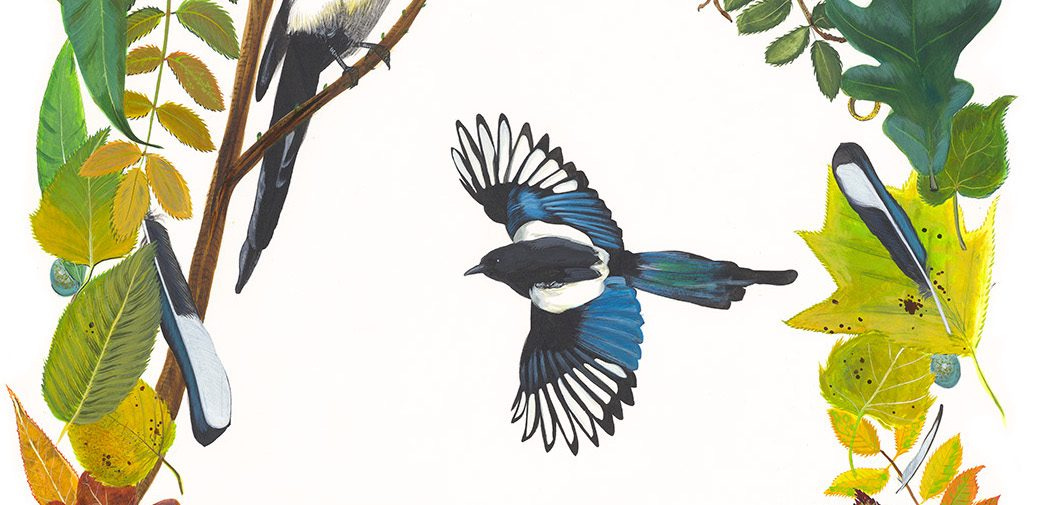#16 The Magpie
Painting by Missy Dunaway. Created with acrylic ink on paper. 30x22 inches (76x56 cm)
Facts About the Magpie
Magpies are one of the UK’s most abundant bird species. Their intelligence and adaptability allow them to thrive across various altered modern landscapes. They are mostly home in gardens, parks, farmland, and urban areas. They avoid treeless landscapes and dense forests.
Magpies congregate in noisy flocks of 5-25 birds, known as parliaments.
Magpies usually live in the wild for 3-5 years but have been known to live into their 20s. Predators include domestic cats, foxes, sparrow hawks, and owls.
An estimated 650,000 Eurasian magpies are found in the United Kingdom, and six subspecies populate Europe, Asia, and western North America. Magpies also inhabit high-elevation areas of Tibet and Kashmir.
Magpie nests are large, dome-shaped structures that take up to eight weeks to build, depending on the breeding pair's availability of materials and experience. The male collects nesting material, and the female is responsible for construction.
The magpie is highly intelligent. The expansion of its nidopallium, the part of the brain that controls executive cognitive functions, is approximately the same relative size as chimpanzees, gorillas, orangutans, and humans. It is the only bird known to pass the mirror test!
This video about Australian magpies explains why magpies thrive in urban environments.
Watch a magpie pass the mirror test and recognize itself.
Shakespeare’s Magpie
Shakespeare’s corvids include the raven, crow, rook, jackdaw, jay, and magpie. Except for the blue jay, these birds often appear together in ominous flocks to plunder the dead. The magpie was thought to be possessed by the devil and channeled his evil words while chattering, an idea suggested by King Henry in Henry VI, Part 3.
Henry VI, Part 3 (Act V, Scene 6, Line 45)
KING HENRY: The owl shrieked at thy birth, an evil sign;
The night-crow cried, aboding luckless time;
Dogs howled, and hideous tempest shook down trees;
The raven rooked her on the chimney’s top;
And chatt’ring pies in dismal discords sung;
Thy mother felt more than a mother’s pain,
And yet brought forth less than a mother’s hope:
To wit, an indigested and deformèd lump,
Not like the fruit of such a goodly tree.
As a representative of the devil, it is fitting that the magpie appears in Macbeth, a play known for witches and cursed prophecies.
Macbeth (Act III, Scene 4, Line 151)
MACBETH: It will have blood, they say; blood will have blood.
Stones have been known to move, and trees to
speak.
Augurs and understood relations have
By maggot pies and choughs and rooks brought
forth
The secret’st man of blood.—What is the night?
A vulture, puttock, and magpie feed on a deceased lion in this illustration by Henry Peacham (Minerua Britanna, 1612). The accompanying adage asserts that carrion birds will only eat upon guilty flesh. If one leads a “life upright,” the birds will move along without satiating their appetite. Folger Shakespeare Library
Magpie, Maggot-pie, or Pie?
“Magot” is a French word for a hoard of secreted money. This title may have been given to the magpie for its tendency to hide things. Or “maggot” could be referring to the magpie’s favorite food.
“Pied” describes something as having two or more colors. For the magpie, this refers to its black and white feathers with a surprising splash of cobalt on its secondary flight feathers. This may explain why “pie” also describes the food dish, a mixture of various things.
Shakespeare uses the word “pied” to mean multi-colored on several occasions unrelated to birds, including this song from Love’s Labor’s Lost:
[SPRING] When daisies pied and violets blue,
And lady-smocks all silver-white,
And cuckoo-buds of yellow hue
Do paint the meadows with delight,
Behind the Painting
Excluding the vibrant blue jay, my challenge is to make Shakespeare’s flock of black, threatening corvids distinctive in their respective paintings. The magpie is the only “pied” corvid from the flock, which sets it apart.
I encircled the magpie in colorful leaves from trees native to the United Kingdom. They morph from springtime to autumnal colors to reference the magpie’s non-migratory, year-round presence in the British Isles. These colorful leaves also play on the meaning of “pied,” or multicolored. Two pieces of 17th-century jewelry are partially hidden and peek out from under the leaves, alluding to the thieving magot-pie, and maggots crawl across the surface of some leaves.
Exit, pursued by a bird
Thank you for subscribing! You can find the full bird profile, including citations and endnotes, at birdsofshakespeare.com/birds.
If you’d like to connect with me, reply to this newsletter or email birdsofshakespeare@gmail.com.
Copyright (C) 2023 The Birds of Shakespeare. All rights reserved.









